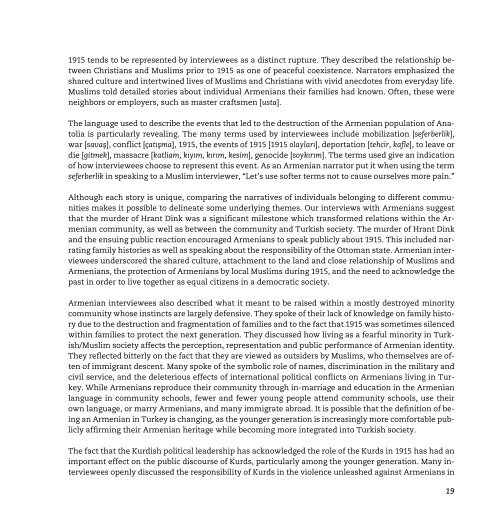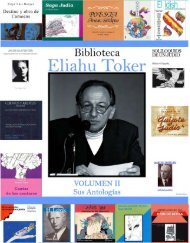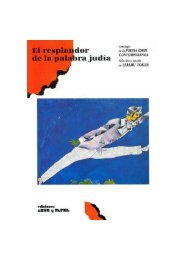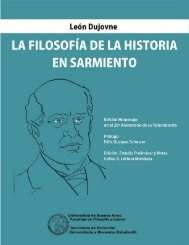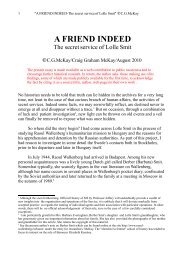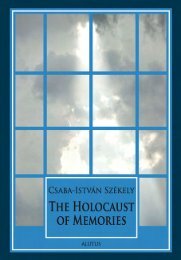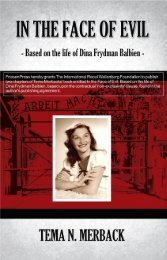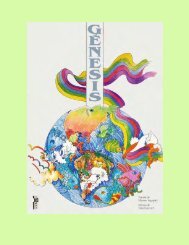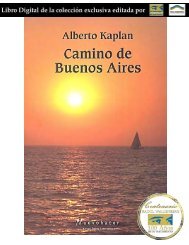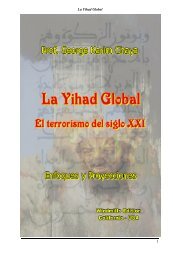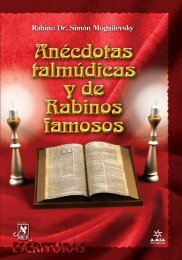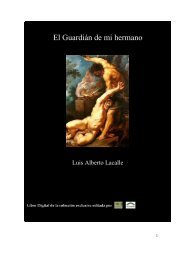Speaking to One Another - The International Raoul Wallenberg ...
Speaking to One Another - The International Raoul Wallenberg ...
Speaking to One Another - The International Raoul Wallenberg ...
- No tags were found...
You also want an ePaper? Increase the reach of your titles
YUMPU automatically turns print PDFs into web optimized ePapers that Google loves.
1915 tends <strong>to</strong> be represented by interviewees as a distinct rupture. <strong>The</strong>y described the relationship betweenChristians and Muslims prior <strong>to</strong> 1915 as one of peaceful coexistence. Narra<strong>to</strong>rs emphasized theshared culture and intertwined lives of Muslims and Christians with vivid anecdotes from everyday life.Muslims <strong>to</strong>ld detailed s<strong>to</strong>ries about individual Armenians their families had known. Often, these wereneighbors or employers, such as master craftsmen [usta].<strong>The</strong> language used <strong>to</strong> describe the events that led <strong>to</strong> the destruction of the Armenian population of Ana<strong>to</strong>liais particularly revealing. <strong>The</strong> many terms used by interviewees include mobilization [seferberlik],war [savaş], conflict [çatışma], 1915, the events of 1915 [1915 olayları], deportation [tehcir, kafle], <strong>to</strong> leave ordie [gitmek], massacre [katliam, kıyım, kırım, kesim], genocide [soykırım]. <strong>The</strong> terms used give an indicationof how interviewees choose <strong>to</strong> represent this event. As an Armenian narra<strong>to</strong>r put it when using the termseferberlik in speaking <strong>to</strong> a Muslim interviewer, “Let’s use softer terms not <strong>to</strong> cause ourselves more pain.”Although each s<strong>to</strong>ry is unique, comparing the narratives of individuals belonging <strong>to</strong> different communitiesmakes it possible <strong>to</strong> delineate some underlying themes. Our interviews with Armenians suggestthat the murder of Hrant Dink was a significant miles<strong>to</strong>ne which transformed relations within the Armeniancommunity, as well as between the community and Turkish society. <strong>The</strong> murder of Hrant Dinkand the ensuing public reaction encouraged Armenians <strong>to</strong> speak publicly about 1915. This included narratingfamily his<strong>to</strong>ries as well as speaking about the responsibility of the Ot<strong>to</strong>man state. Armenian intervieweesunderscored the shared culture, attachment <strong>to</strong> the land and close relationship of Muslims andArmenians, the protection of Armenians by local Muslims during 1915, and the need <strong>to</strong> acknowledge thepast in order <strong>to</strong> live <strong>to</strong>gether as equal citizens in a democratic society.Armenian interviewees also described what it meant <strong>to</strong> be raised within a mostly destroyed minoritycommunity whose instincts are largely defensive. <strong>The</strong>y spoke of their lack of knowledge on family his<strong>to</strong>rydue <strong>to</strong> the destruction and fragmentation of families and <strong>to</strong> the fact that 1915 was sometimes silencedwithin families <strong>to</strong> protect the next generation. <strong>The</strong>y discussed how living as a fearful minority in Turkish/Muslimsociety affects the perception, representation and public performance of Armenian identity.<strong>The</strong>y reflected bitterly on the fact that they are viewed as outsiders by Muslims, who themselves are oftenof immigrant descent. Many spoke of the symbolic role of names, discrimination in the military andcivil service, and the deleterious effects of international political conflicts on Armenians living in Turkey.While Armenians reproduce their community through in-marriage and education in the Armenianlanguage in community schools, fewer and fewer young people attend community schools, use theirown language, or marry Armenians, and many immigrate abroad. It is possible that the definition of beingan Armenian in Turkey is changing, as the younger generation is increasingly more comfortable publiclyaffirming their Armenian heritage while becoming more integrated in<strong>to</strong> Turkish society.<strong>The</strong> fact that the Kurdish political leadership has acknowledged the role of the Kurds in 1915 has had animportant effect on the public discourse of Kurds, particularly among the younger generation. Many intervieweesopenly discussed the responsibility of Kurds in the violence unleashed against Armenians in19


